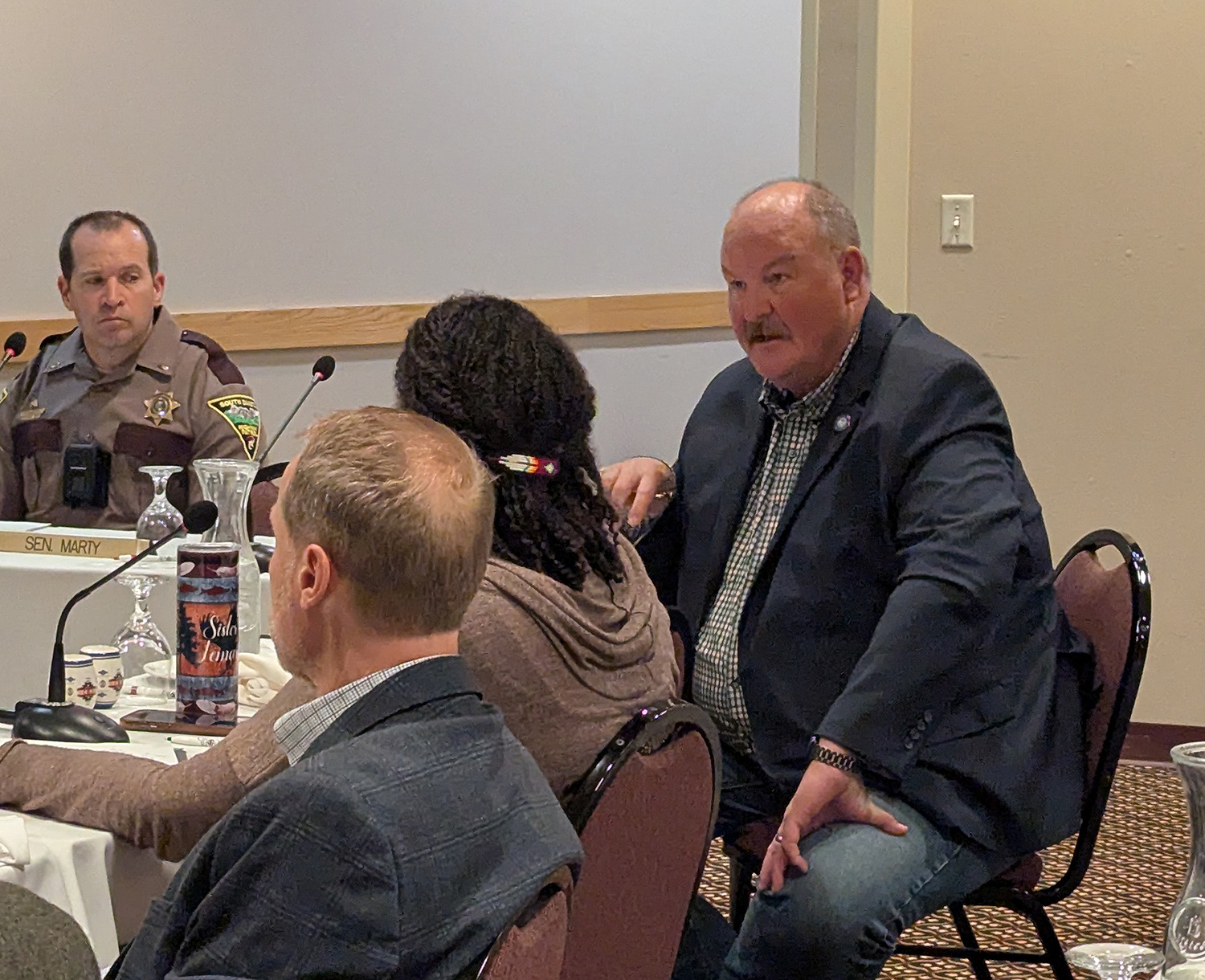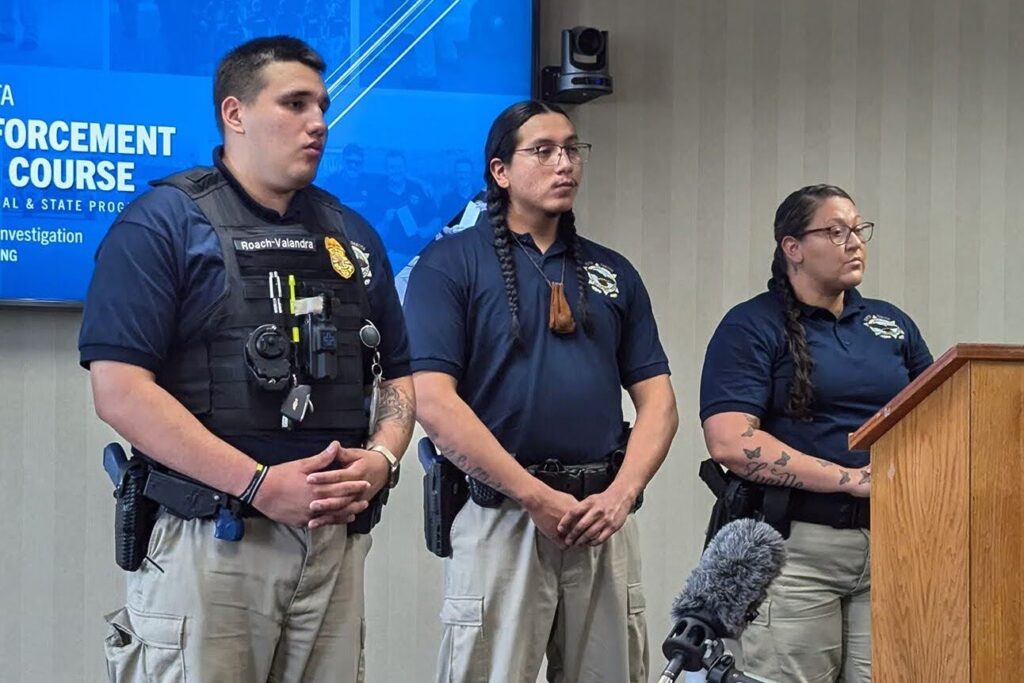Ashaun Roach-Valandra, Sisseton Wahpeton Law Enforcement Services; Akia Winters, Oglala Sioux Tribe Department of Public Safety; and Michelle Casiano, Sisseton Wahpeton Law Enforcement Services, are pictured on July 8, 2024, at the George S. Mickelson Law Enforcement Center in Pierre. (John Hult/South Dakota Searchlight)
MOBRIDGE — South Dakota will offer a 13-week police certification course that gives priority to tribal recruits once every summer, the head of South Dakota’s Division of Criminal Investigation recently told the State-Tribal Affairs Committee.
Speaking at the Grand River Resort, just west of Mobridge on the Standing Rock Reservation, Division Director Dan Satterlee told the committee and representatives from three of South Dakota’s tribes that the state wants to make it easier to recruit and train police on reservations. The committee met Sept. 19.

Training tribal police in-state helps tribal and local officers, Satterlee said, because the recruits get to know the counterparts they might need to work with during joint investigations.
“When they go to training together, they can build those connections and build those relationships,” Satterlee said.
This year’s tribal-priority basic law enforcement certification class began in August, Satterlee said, and nine people in the class work for tribal agencies.
The news was one of several nods during the meeting to efforts at improving police coordination between the state and tribal agencies.
Local training a recent focus for tribes, state
Law enforcement officers in South Dakota are required to complete the basic training course within a year of being hired by a local police agency. Tribal officers also need certification, but have traditionally gone to New Mexico for training with the federal Bureau of Indian Affairs. That basic training includes the same requirements as the Pierre-based academy — proficiency in firearms, training in self-defense, arrest protocols and the like — but also covers the unique legalities of working in tribal areas.
Because the New Mexico academy is open to all tribal recruits, the state has traditionally given preference to non-tribal officers when filling slots at its own police academy. Each state course can fit 48 officers, so if slots remain for a particular class in the past, Satterlee said, tribal recruits on a waiting list would get a call.
Last year, though, then-Gov. Kristi Noem moved money from her office’s budget to fund an additional class that would admit tribal officers first. Nine tribal officers were certified through that first course last year, alongside officers from other agencies. Another four have since been certified.
This year, legislators provided $175,000 to conduct another tribes-first course each summer. Officers willing to go to New Mexico don’t struggle to find slots, Satterlee said, but “unlike coming to our academy, they can’t visit their families on the weekends.”
Cheyenne River Sioux Tribal Chairman Ryman LeBeau, who was on hand for the committee meeting, asked Satterlee if the state would admit more than nine tribal recruits.
“We can fill up to 48, and we’d love to have 48,” Satterlee said. “For this one, we had nine that applied and made it through the background check, etcetera, so we had nine enrolled.
Legislation suggested to formally recognize tribal officers
U.S. Sen. Mike Rounds, R-South Dakota, has pushed for a federal tribal training academy for the Great Plains, most recently this spring by sending a letter to Interior Secretary Doug Burgum.
Retiring Standing Rock tribal chairwoman calls for more communication with South Dakota leaders
Satterlee said he’d like to see it in South Dakota.
The State-Tribal Affairs Committee voted unanimously to urge the state Legislature to pass a resolution supporting a federal tribal academy in the state.
The committee also voted to move forward with drafting a bill for the 2026 legislative session that would recognize tribal officers as law enforcement under state law. Assaulting an officer can draw felony charges in South Dakota, but not if the officer assaulted works for a tribal agency. The committee would like to update the definition, noting that tribal officers often assist their state- or local counterparts for incidents on state land.
Surge at Standing Rock
State Department of Public Safety Secretary Bob Perry told tribal leaders at the committee meeting that the state would be happy to sign agreements for assistance with tribes.
The Highway Patrol has a memorandum of understanding with the Crow Creek Sioux Tribe to patrol during the tribe’s annual powwow.
Tribal leaders have sometimes been reluctant to open their borders to state police out of concerns that the visiting force might step beyond assistance and do things like serve state warrants on tribal citizens, Perry said.
Perry said agreements with the state would mean “we’d come when we are requested, and leave when we’re asked.”
“We don’t come in and try to serve state warrants or issue state citations or gather intelligence for state crimes,” Perry said.
The Standing Rock Sioux Tribe partnered with the state Highway Patrol for a temporary surge patrol between July 20 and Aug. 2. That partnership resulted in 13 citations and 47 warnings during 36 total hours of trooper patrols on Standing Rock, Highway Patrol Lt. Caleb Walters said. The patrol did not make any arrests, he said.
Standing Rock police did make arrests in the coordinated event. Derris Waukazoo, Standing Rock’s police chief, told the committee the surge came in two phases, the first focusing on the service of warrants and the second on patrols.
Waukazoo’s officers logged 817 incidents, which include any contact with people, and 75 arrests for crimes ranging from drunken driving and public intoxication to aggravated assault.
Arrests also included drug possession, which Waukazoo said is a driver of a lot of reservation crime.
Callback to cartel controversy
Janet Alkire, who attended the committee meeting during her last week as chairwoman for that tribe, said Standing Rock’s call for help was necessary. She also said there are opportunities for collaboration in the future, though a formal agreement will likely remain a hard sell.
She was pleased to hear Satterlee and Perry talk about the kind of assistance they can offer without such an agreement, such as help with missing persons cases, or during disasters.
“I’m really grateful for that,” Alkire said.
She also gave a nod to the controversial remarks from former Gov. Noem that helped spark discussions on an additional training course for tribal recruits.
Noem alleged Mexican drug cartels had infiltrated tribal areas during a speech to lawmakers, and repeated the claim several times in the months that followed. All nine tribes banned her from their lands based on those comments, as well as comments tribal officials viewed as disparaging to Native American children.
Alkire asked Waukazoo if any of the arrests in the summer surge involved cartel members.
“No,” he said, an answer that elicited laughter from the room.
“We’re kind of joking about it, but it’s a serious question, and we really did want to know, because we actually don’t know sometimes who comes on our lands,” Alkire said.
The tribe is welcoming to outsiders, but last year’s comments sparked questions from tribal members, Alkire said.
“When something gets out there like that, that we have the cartels infiltrating, it scares our people,” she said.
YOU MAKE OUR WORK POSSIBLE.





